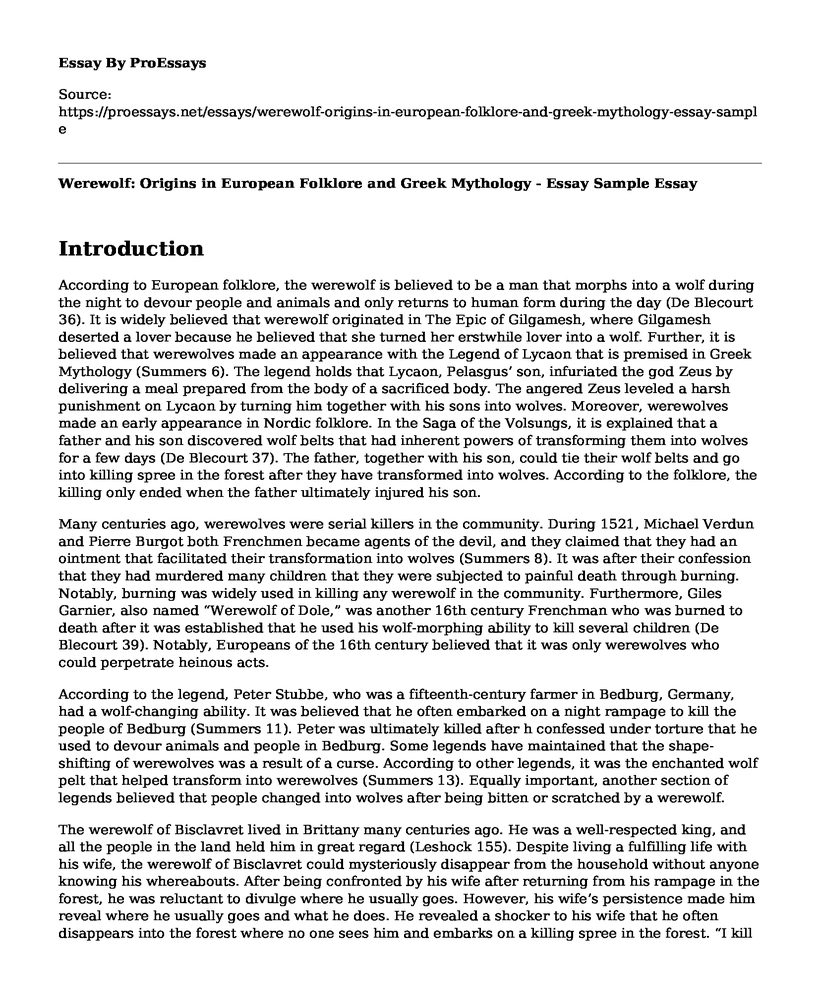Introduction
According to European folklore, the werewolf is believed to be a man that morphs into a wolf during the night to devour people and animals and only returns to human form during the day (De Blecourt 36). It is widely believed that werewolf originated in The Epic of Gilgamesh, where Gilgamesh deserted a lover because he believed that she turned her erstwhile lover into a wolf. Further, it is believed that werewolves made an appearance with the Legend of Lycaon that is premised in Greek Mythology (Summers 6). The legend holds that Lycaon, Pelasgus’ son, infuriated the god Zeus by delivering a meal prepared from the body of a sacrificed body. The angered Zeus leveled a harsh punishment on Lycaon by turning him together with his sons into wolves. Moreover, werewolves made an early appearance in Nordic folklore. In the Saga of the Volsungs, it is explained that a father and his son discovered wolf belts that had inherent powers of transforming them into wolves for a few days (De Blecourt 37). The father, together with his son, could tie their wolf belts and go into killing spree in the forest after they have transformed into wolves. According to the folklore, the killing only ended when the father ultimately injured his son.
Many centuries ago, werewolves were serial killers in the community. During 1521, Michael Verdun and Pierre Burgot both Frenchmen became agents of the devil, and they claimed that they had an ointment that facilitated their transformation into wolves (Summers 8). It was after their confession that they had murdered many children that they were subjected to painful death through burning. Notably, burning was widely used in killing any werewolf in the community. Furthermore, Giles Garnier, also named “Werewolf of Dole,” was another 16th century Frenchman who was burned to death after it was established that he used his wolf-morphing ability to kill several children (De Blecourt 39). Notably, Europeans of the 16th century believed that it was only werewolves who could perpetrate heinous acts.
According to the legend, Peter Stubbe, who was a fifteenth-century farmer in Bedburg, Germany, had a wolf-changing ability. It was believed that he often embarked on a night rampage to kill the people of Bedburg (Summers 11). Peter was ultimately killed after h confessed under torture that he used to devour animals and people in Bedburg. Some legends have maintained that the shape-shifting of werewolves was a result of a curse. According to other legends, it was the enchanted wolf pelt that helped transform into werewolves (Summers 13). Equally important, another section of legends believed that people changed into wolves after being bitten or scratched by a werewolf.
The werewolf of Bisclavret lived in Brittany many centuries ago. He was a well-respected king, and all the people in the land held him in great regard (Leshock 155). Despite living a fulfilling life with his wife, the werewolf of Bisclavret could mysteriously disappear from the household without anyone knowing his whereabouts. After being confronted by his wife after returning from his rampage in the forest, he was reluctant to divulge where he usually goes. However, his wife’s persistence made him reveal where he usually goes and what he does. He revealed a shocker to his wife that he often disappears into the forest where no one sees him and embarks on a killing spree in the forest. “I kill and eat wild animals and plants and go like a beast in the woods where no one can find me. I am Bisclavret.” (Leshock 159) The erstwhile folklores relate with the werewolf of Bisclavret as they could also disappear into the darkness and engage in heinous crimes after they have transformed into werewolves.
Works Cited
De Blecourt, Willem, ed. Werewolf histories. Springer, 2015, pp. 35-40.
Leshock, David B. "The Knight of the Werewolf: Bisclavret and the Shape-Shifting Metaphor." Romance Quarterly 46.3 (1999): 155-165.
Summers, Montague. The werewolf in lore and legend. Courier Corporation, 2003, pp. 6-14.
Cite this page
Werewolf: Origins in European Folklore and Greek Mythology - Essay Sample. (2023, Aug 12). Retrieved from https://proessays.net/essays/werewolf-origins-in-european-folklore-and-greek-mythology-essay-sample
If you are the original author of this essay and no longer wish to have it published on the ProEssays website, please click below to request its removal:
- Compare and Contrast Essay Example: Forms of Slavery Today and in the Movie Slavery by Another Name
- Roman's Growth to a Position of a Great Political and Cultural Power
- Dennis Kearny and Wong Chin-Fu Paper Example
- Myths: Perseus, Zeus and Danae - Essay Sample
- Essay Example on Hamlet: Mortality, Dreams, and Final Loneliness
- Essay Example on Armenian Genocide: 600,000-1.5 Million Lives Lost, Turkish Denial
- Slavery - Free Essay Sample







